
The safety industry is continually improving Personal Flotation Devices (PFDs) — also commonly called life jackets or life vests — for water activities and water conditions to encourage the full-time use of PFDs. The result is a vast amount of choices for the consumer. This buyer's guide provides information on PFD types and tips for choosing a life vest.
Safety Requirements for Boats
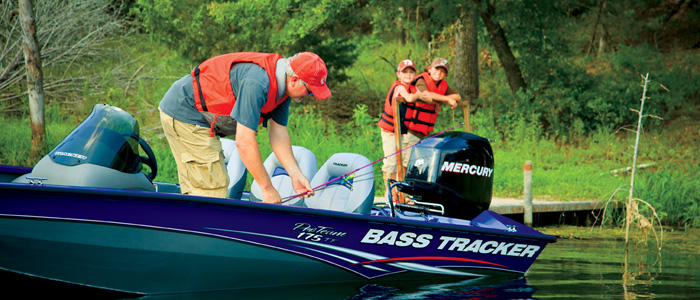 The US Coast Guard's Federal Requirements state, "All recreational boats must carry one wearable PFD (Type I, II, III, or Type V) for each person aboard... [and that] any boat 16 foot and longer (except canoes and kayaks) must also carry one throwable Type IV PFD." PFDs should be Coast Guard approved and in good condition. They must also be the proper size for the intended user. State laws vary on PFD use, but units must be readily accessible in case of an emergency. In some states children must wear PFDs in certain sized boats or for specific boating activities. Furthermore, adults accompanying children should also have PFDs on at all times to immediately assist a child in an emergency situation. Federal, State, and local park authorities
The US Coast Guard's Federal Requirements state, "All recreational boats must carry one wearable PFD (Type I, II, III, or Type V) for each person aboard... [and that] any boat 16 foot and longer (except canoes and kayaks) must also carry one throwable Type IV PFD." PFDs should be Coast Guard approved and in good condition. They must also be the proper size for the intended user. State laws vary on PFD use, but units must be readily accessible in case of an emergency. In some states children must wear PFDs in certain sized boats or for specific boating activities. Furthermore, adults accompanying children should also have PFDs on at all times to immediately assist a child in an emergency situation. Federal, State, and local park authorities 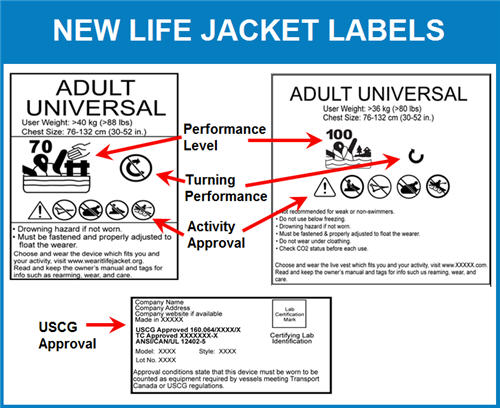 may also have regulations regarding PFDs in their waters
may also have regulations regarding PFDs in their waters
Safety Labels on Life Jackets Change in 2019
In 2019, the safety labels on life jackets replaced words with icons. The traditional floating "Types" categories are going away. Life jackets with old tags still meet all regulatory requirements until no longer serviceable. Learn more at U.S. Coast Guard Auxiliary here.
Types of PFD Flotation: Life Jackets, Cushions, Throw Raft or Life Vests
PFD flotation can be divided into two main categories. The first type of PFD flotation is inherently buoyant. The device's buoyancy is a result of the materials used, often foam panels. These PFDs come in all sizes and are for both swimmers and non-swimmers. Inherently buoyant PFDs were the mainstay for years for water sports and recreational boating. Improvements in design and features have made these PFDs more comfortable to wear.
Inflatable PFDs can be seen as the second generation of life vests. These devices come in automatic and/or manual inflating models. Manual models are inflated by pulling a tab. They can also be blown up with an included tube if for some reason the tab doesn't operate properly. Automatic models are inflated via a C02 cartridge that is triggered by a sensor that activates once it hits the water. These also have a manual back-up option. Inflatables are less bulky than inherently buoyant PFDs because they are only inflated when an individual is in the water. Inflatable PFDs also require minor maintenance to keep them ready for inflation when needed, such as keeping the C02 cylinder full and the unit's status indicators green at all times.
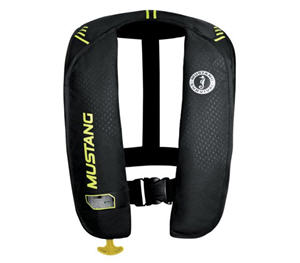
Inflatable Life Vest
Hybrid life jackets and vests like the Mustang M.I.T. 100 Auto Inflatable Life Vest are another type of flotation device. They combine inherently buoyant materials as well as inflation technology. They come in all sizes except infant. In many ways, hybrids combine the best of both worlds in PFD design and come in carrying models, including some for water sports.
Type I Life Jacket
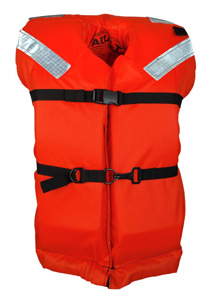 Type I PFDs, or offshore life vests, are the most buoyant PFDs and suitable for all water conditions, including rough or isolated water where rescue may be delayed. Although bulky in comparison to Type II and III PFDs, offshore vests will turn most unconscious individuals to the face-up position. They range in sizes from adult to child.
Type I PFDs, or offshore life vests, are the most buoyant PFDs and suitable for all water conditions, including rough or isolated water where rescue may be delayed. Although bulky in comparison to Type II and III PFDs, offshore vests will turn most unconscious individuals to the face-up position. They range in sizes from adult to child.
Type ll Life Vest
Type II PFDs, or near-shore buoyancy vests, are for calm and open water where a rescue will occur quickly. They are not designed for long periods in rough water. These vests will turn some, but not all, unconscious wearers face-up in the water. Some inflatable Type II models will turn wearers to the face-up position as well as a Type I PFD. This vest is less bulky 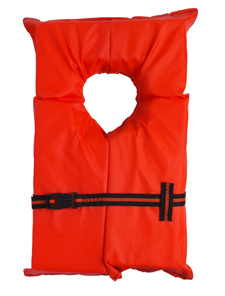 than a Type I and often the least expensive of the PFD types.
than a Type I and often the least expensive of the PFD types.
Type II PFDs are available in a variety of sizes. It is advisable that a child wear, at minimum, a Type II PFD.
Type lll Life Vest

Type III PFD jacket
Type III PFDs like the Mustang Survival Catalyst Jacket USCG-approved Type III PFD are the most popular for recreation boating and fishing, as they're the most comfortable to wear. These flotation aids are for calm and open water where a rescue will likely occur quickly. These PFDs are designed to keep the wearer in a vertical position. It is the wearer's responsibility to maneuver themselves into a face-up position, usually accomplished by tilting their head back. Type III inflatable models will keep unconscious wearers face-up as well as a Type II inherently buoyant vest. This PFD is not recommended for rough water conditions. Type III PFDs come in various sizes from adult to child.
Type lV Flotation Cushion

Type IV flotation cushion, or throwable devices, are for calm conditions where rescue will happen quickly. Not designed to be worn, these PFDs are tossed to a conscious person who can hold onto it for flotation until rescued. A square buoyant cushion, a life ring like the Taylor Made Vinyl-Coated Life Ring that features floating grab lines secured to the foam core and US Coast Guard approved or, a horseshoe buoy, are some Type IV examples.

CushionType lV
Tip: The Throw Raft Inflatable Throw Cushion is the USCG-approved Type-IV PFD inflatable, throwable device. Five times smaller than a square cushion when packed. It also inflates automatically when submerged, letting you throw it accurately to a person in need.
Type V Life Vest
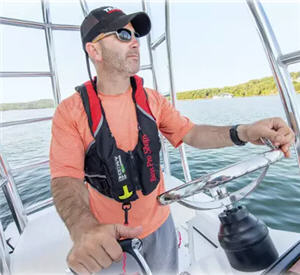
Auto/Manual Inflatable Life Vest -
USCG-approved Type V with Type II
performance in automatic mode and
Type III performance in manual mode.
Type V PFDs are also referred to as special use devices. These devices are to be worn for specific activities as described on the unit's label. To be effective Type V PFDs must be used in accordance with the label's specifications. Many must be worn at all times in order to qualify as a PFD. A Type V's label will also list its performance as a Type I, II, or III PFD. A Type V PFD, like a full body survival suit, provides protection from hypothermia; however, these suits are best suited for cool climates as they can become quite warm in mild or hot weather.
Selecting the Best Life Jacket for Your Needs
"The best life jacket is the one you wear," is a common water safety phrase. Begin selecting your PFD by reading the label and making sure the device is U.S. Coast Guard approved for: your size and weight; the type of activities you'll be doing; and the water you'll encounter. For some, this may mean having various PFDs for different situations. For example, an angler may have a Type III PFD for small inland lakes, and a Type I for larger water bodies.
Fitting Tips to Ensure Your PFD Fits Properly

considered a Type V PFD
with Type III performance,
are less bulky and allows
for more arm movement.
The next important step in choosing a PFD is to make sure it fits properly and is comfortable. Try on several models with different amounts of clothing to gauge how the PFD will feel when worn at various times throughout the year. Adjustable straps will help you alter the fit for the amount of clothing you'll wear. Note that a PFD should fit snug; if it is too loose it will not provide proper flotation in the water. A common fitting procedure is to put on the PFD, and tighten all straps and close zippers. Next, raise your arms above your head and have someone try and lift the PFD up by the shoulders. The unit is not a proper fit if it is too loose. Signs of this are if the device freely moves and almost comes off, or if the main zipper touches your nose.
Life Jackets for Children
Like sizing an adult PFD, the procedure is similar for a child. The vest should fit snug. To test the fit, tighten all straps and close zippers and then lift the child by holding the PFD's shoulders. The child's ears and neck should not slip though the head opening. It is also advisable that a child wear, at minimum, a Type II PFD.
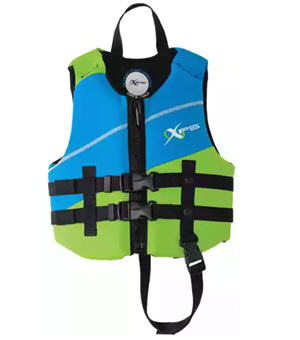
for Kids USCG Approved
Type II
Adult and child PFDs should also be water tested after purchase to ensure they're a proper fit. The advantage to testing a child's PFD is not only to ensure proper fit and flotation. It's an opportunity for your child to become comfortable with the device on in the water. Help your child get comfortable in the water and explain why they need to wear a PFD. This will help them remain calm in an emergency.
Additional PFD Safety Features and Accessories
Features to look for in a PFD include brightly colored material as well as reflective tape so you can be easily seen on, and in, the water. Most PFDs today are made out of durable, water resistant materials, such as 200-denier nylon. Older models were often made of cotton or other slow-drying fabrics, resulting in mildew quickly growing on damp PFDs. Some recent models have padded or fleece-lined collars to provide extra comfort in cool conditions.
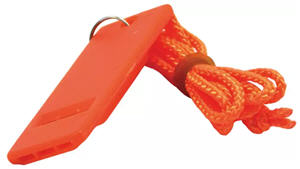
Large buckles and snaps make removing vests easier in damp or cool weather. Corrosion resistant and oversized zippers are also good features in a PFD. Pockets are also important. Hand-warmer side pockets can help take the chill out of cold fingers, while chest, cargo, mesh or internal pockets are great to carry personal and functional items. Finally, a D-ring allows for clip-on accessories, like the Bass Pro Shops Flat Marine Safety Whistle or fishing line cutters.
The best practice is to regularly wear your PFD at all times when on or near water. This buyer's guide has provided some details on the types of PFDs available and selection tips, but the ultimate responsibility rests with you to properly select a PFD for your intended use. Safe boating!
- 11977 views

